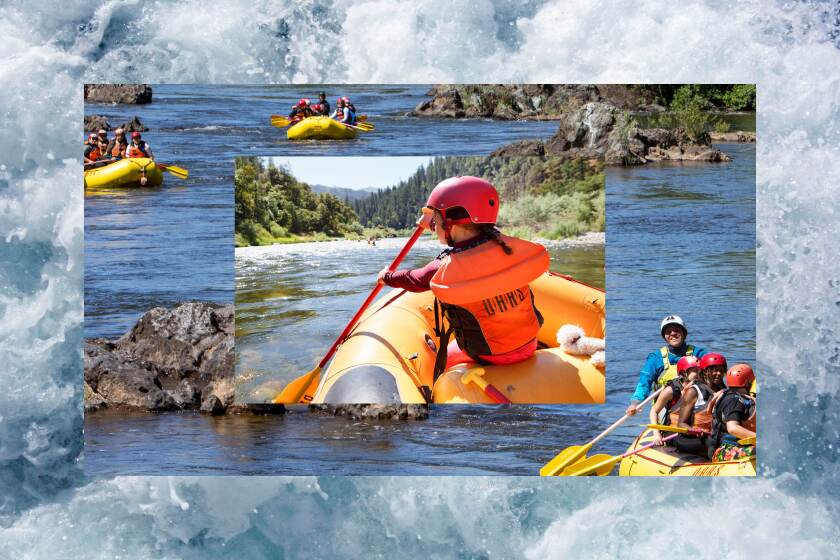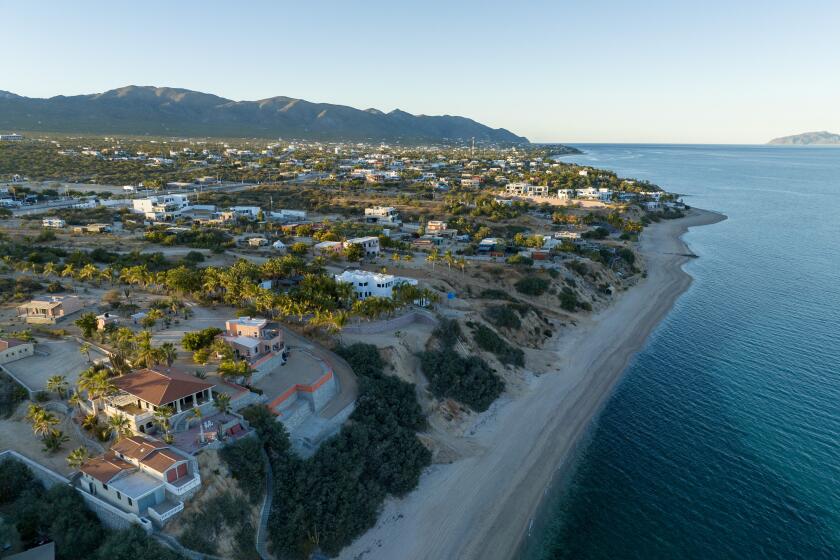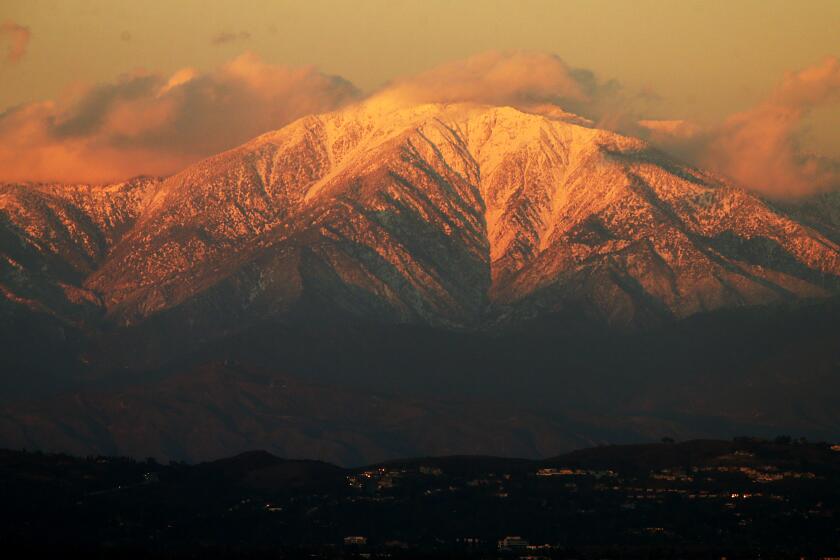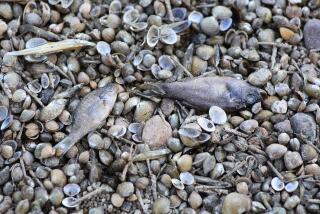Record storms and epic snowpack will mean plenty of water for rafting companies like Sierra South Mountain Sports, shown here leading an early-season tour on the Upper Kern River. (Myung J. Chun/Los Angeles Times)
- Share via
UPPER KERN RIVER — Imagine racing down a steep river of recently melted snow toward a roaring rapid.
You’re sitting on the outside edge of an inflatable raft with a paddle in your hands, so you can’t hold onto anything else. All that’s keeping you in the boat — and out of the freezing water — are your feet wedged into slippery seams of rubber on the raft’s floor.
Then the guide at the helm, a world-class whitewater specialist who grew up on this stretch of the Kern River and whose intimate knowledge of the spot is all that stands between you and disaster, jumps to his feet, stares at the approaching rapid and says, “Wow, this changed.”
A second later your world explodes: the raft dives into a deep trough and smashes into a standing wave, the first of many. You’re at the front, so you take the full force of unspeakably cold water in the face. Gallon after freezing gallon finds its way inside your wetsuit and down your spine.
You gasp and struggle to keep your balance while heeding the commands to paddle, “FORWARD TWO,” “BACK TWO,” “FORWARD. FORWARD. FORWARD.”
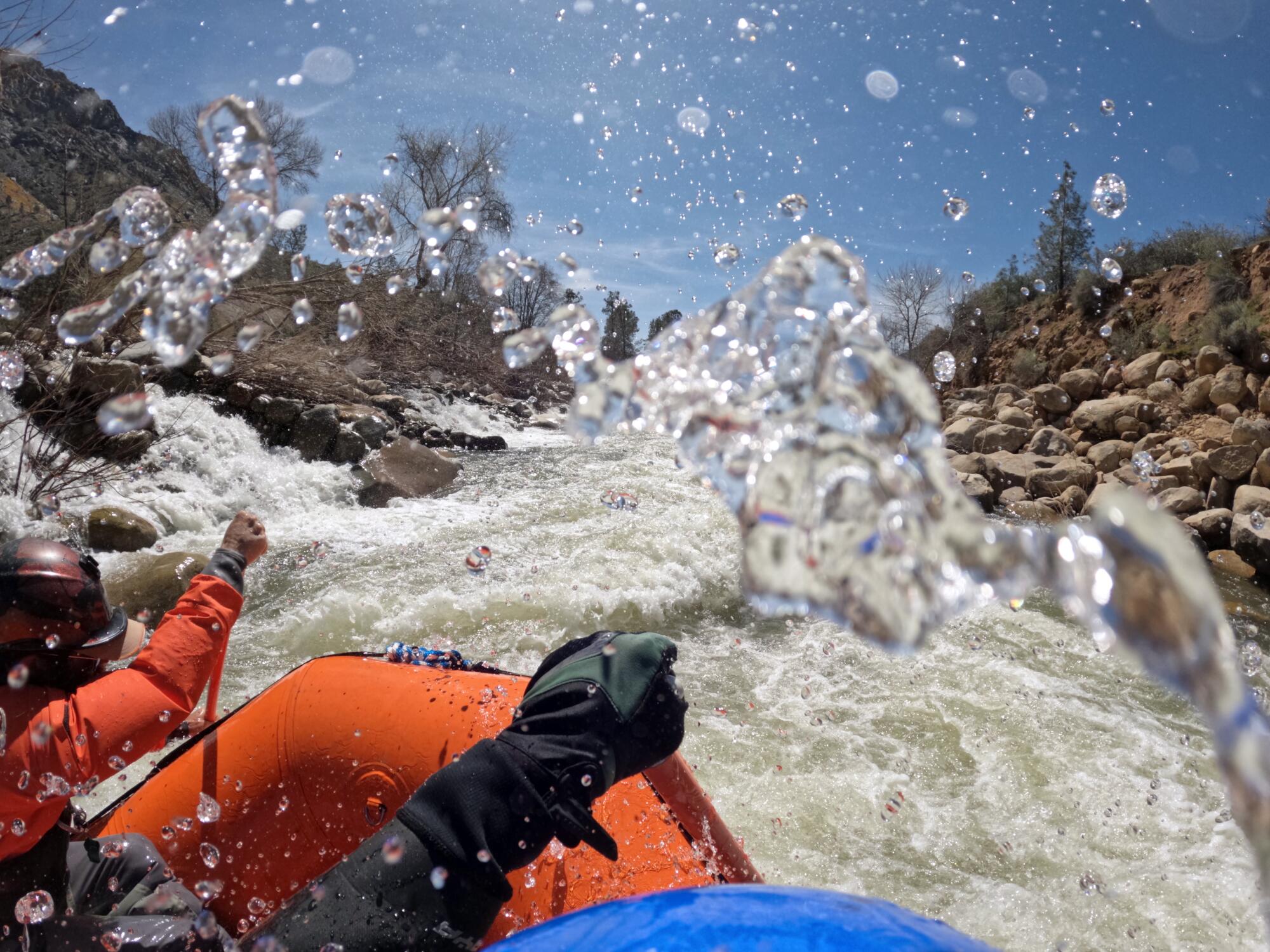
And then, as suddenly as it began, you exit the rapid, and the chaos ends. You can’t stop grinning.
If this sounds like fun, you’re in luck: California is on the brink of a whitewater rafting season for the ages.
Thanks to this year’s epic snowpack, some of the Golden State’s most popular whitewater streams will be pumping into the fall. Here’s what to know as you plan your trip.
As the record Sierra snowpack begins to melt, it is sending immense volumes of water cascading through some of the most storied and beautiful rafting rivers in the world: the Kern in the southern Sierra, the Tuolumne, which flows out of Yosemite National Park, and the American flowing out of the mountains near Lake Tahoe.
This “big melt” could wreak havoc on the towns and farms that line the rivers and irrigation channels interlacing the Central Valley. But for whitewater rafting guides, whose small, often family-owned businesses have struggled to stay afloat through years of punishing drought, the deluge is a godsend.
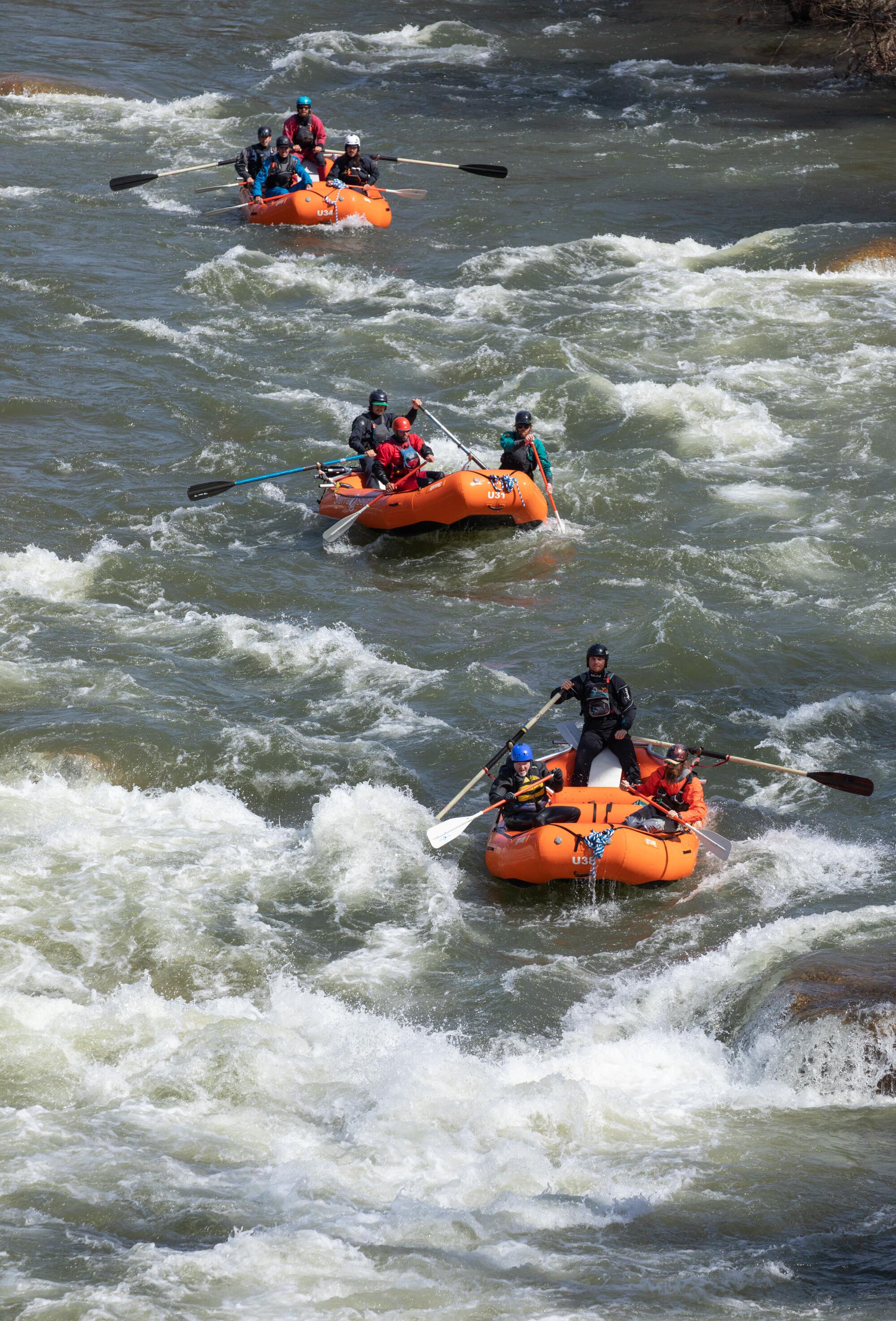
“We’re going to have excellent flows and a really long season,” said Evan Moore, 27, who started kayaking when he was 4 years old. Now he manages Sierra South Mountain Sports in Kernville, a rafting company his dad started in 1985.
Each year, the Moores hope to stay open from early April through Labor Day, but California’s prolonged drought made that all but impossible. Last year, they had to close for the season in mid-August. In 2021, they shut down July 10. And the year before that, the pandemic shut them down for much of the season.
This year, they’re hoping to stay open through Halloween. So they’re hiring guides, drivers and clerks. All told, the staff could number about a hundred.
“We’ll probably run out of people wanting to go rafting before we run out of water,” Moore said.
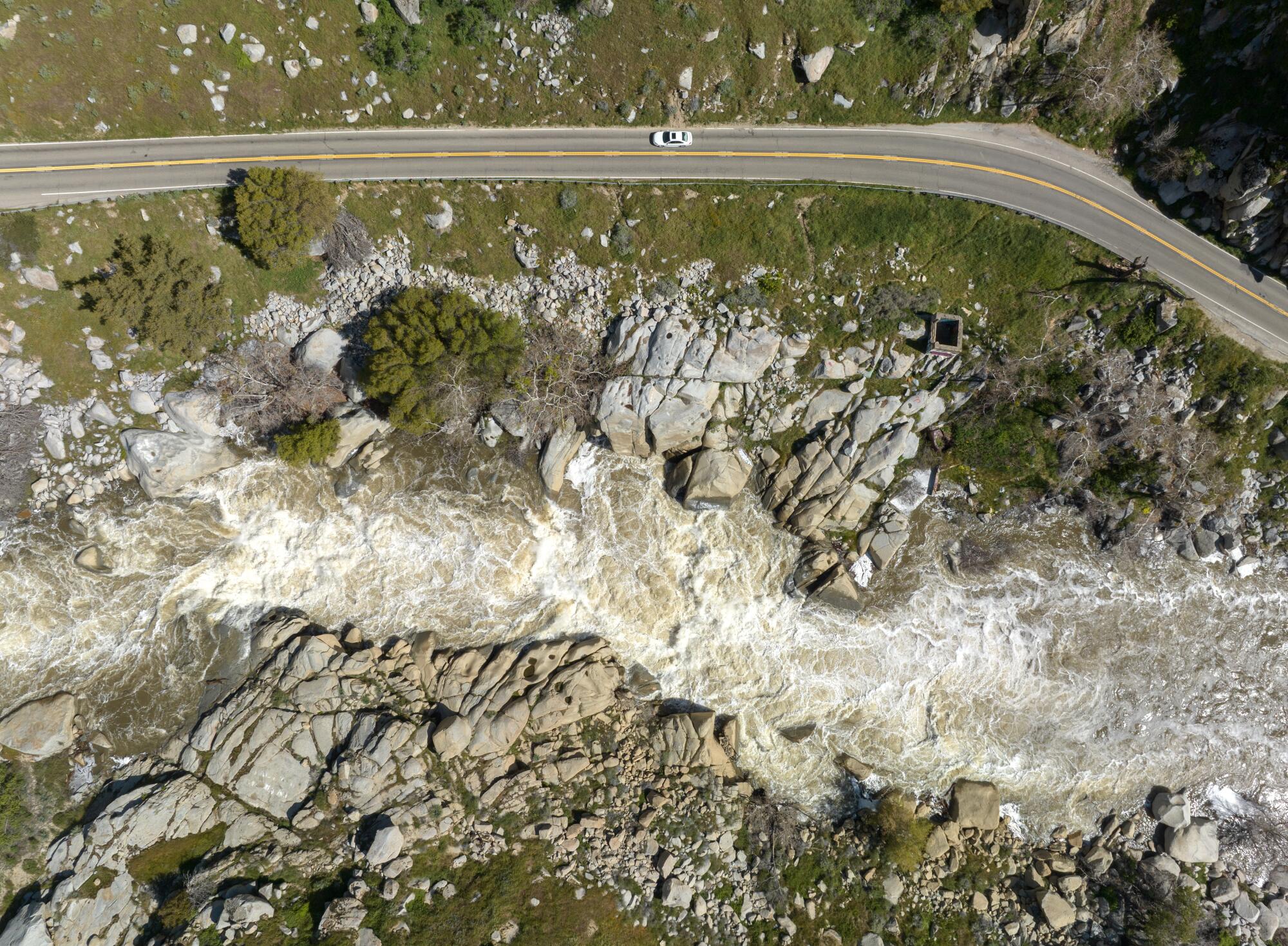
Whitewater guides across the Sierra are saying much the same. But the sudden bounty of water creates new obstacles — some logistical, others more perilous.
“It’s exciting and problematic,” said Tom McDonnell, owner and lead guide of Sierra Mac River Trips in Groveland, a Gold Rush town on the Highway 120 route to Yosemite. The start of their season is delayed because the steady flow of atmospheric rivers this winter washed out the road leading to their normal launch sites.
Adam Ferguson, who manages Zephyr Whitewater Expeditions in Columbia in the Tuolumne County foothills, faced the same problem. “It’s pretty frustrating to have this amazing river flowing and just not be able to get to it.”
A quirk of geography has created a spot in southern Baja with nearly perfect winds for kitesurfing. In the last few years, Californians have built a thriving outpost there. Is the growth sustainable?
Once access is restored, the next hurdle will be navigating the sheer volume of water flowing and preparing for the torrents yet to come.
Rapids are rated on a scale of Class I to VI: Class I is a ripple, and VI is too dangerous to navigate. Even with this year’s high flows, California will still have plenty of stretches of river with Class I, II and III rapids suitable for first-timers and families with kids.
But the rivers flowing down the western slopes of the Sierra are considered among the best in the world due to the abundance of Class IV and V rapids. They’re exciting enough to get an adventurous heart pumping, and in normal years, safe enough for fit, properly equipped clients with an experienced guide at the helm.
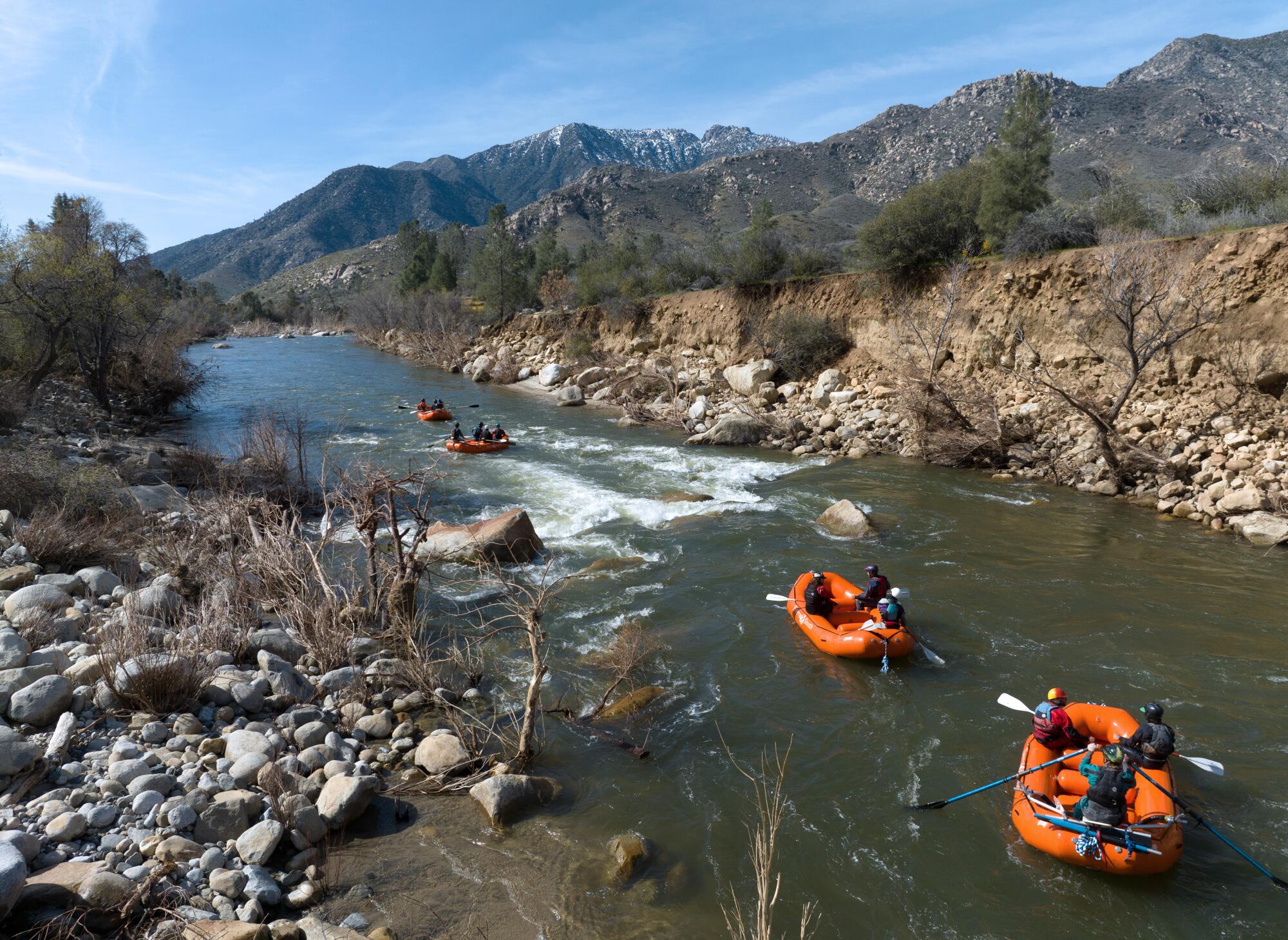
This year, with conditions so outsized and unfamiliar, guides may have to rethink those ratings and reassess what “safe enough” means. High water not only makes rivers flow faster, it also changes the dynamics of previously well-known rapids. That increases the odds of things going wrong and raises the stakes when they do.
In some cases, the rocks that create rapids might be so submerged that the water flowing over them is undisturbed, making them flat and dull. But more likely, said McDonnell, the water will be moving with such force that, even when some rocks are submerged, the surface will be affected in unpredictable ways.
One boat in a group might enjoy big, smooth “roller-coaster” waves, McDonnell said. And the next might get a 12-foot “Hawaii Five-O”-style wave breaking right on top of it.
“There’s not that many people who know how to deal with that,” McDonnell said.
Even guides who do know how to deal with it will have to recover quickly, because the next rapid will be approaching faster than usual. “If we don’t think there’s any chance to recover,” before the next rapid, McDonnell said, “then we have to consider it Class VI, just un-runnable.”
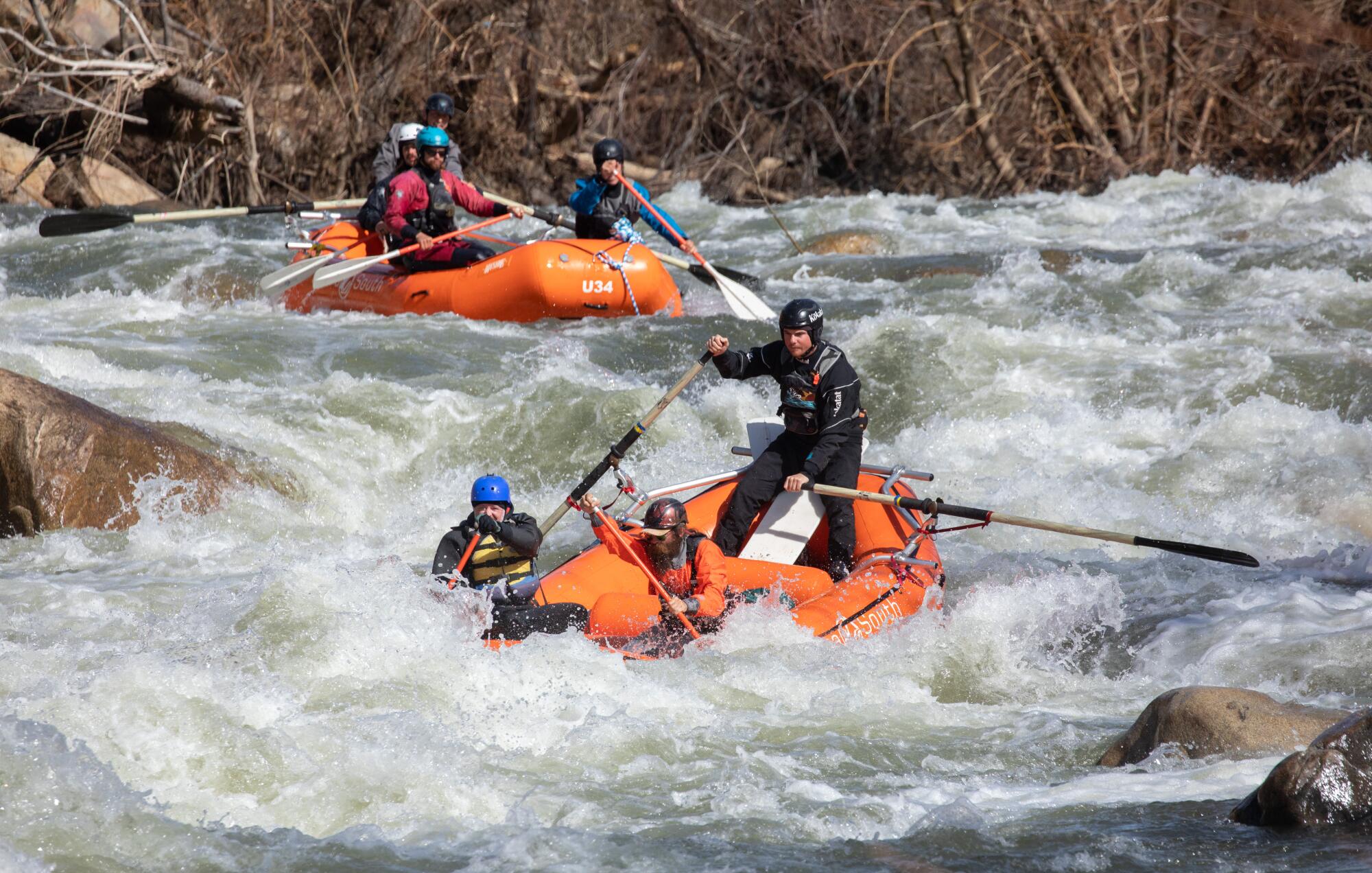
That means rafting companies will have to screen guides with extra care this year, and guides will have to do the same with clients before taking them to the most adventurous spots.
Ferguson said one technique is to take clients through one rapid to let them “get a big wave kind of blasting in the face,” and then go to a calm eddy for a swim test.
“You don’t have to be an Olympic swimmer or anything,” Ferguson said, but you have to perform a few competent strokes and prove you can listen to directions. “Every once in a while, you get someone who jumps in and they’re just fully deer in the headlights. Nothing you say is getting through.”
When that happens, Ferguson said, he gently explains, “This probably isn’t the trip for you.”
Mt. Baldy towers over Southern California, beautifully decked with snow. Easy access helps make it one of the three deadliest peaks in the U.S. This winter, rescue crews have been busy.
The entrance exam will be tougher-to-raft Cherry Creek, an innocently named section of the Upper Tuolumne River that’s considered one of the most challenging commercially run rafting trips in the United States.
McDonnell, whose father pioneered trips on Cherry Creek in the 1970s, said he typically starts taking clients there in April or May. This year, he said, water levels will be so high he probably won’t start running it until August.
Even then, he’ll ask potential clients to demonstrate they can run 30 meters uphill on a single breath. He’ll also put them through drills showing they can quickly follow orders to paddle forward, backward and stop. And they’ll have to prove they’re agile enough to dive to the bottom of the raft at a moment’s notice and bounce back up to their paddling position on the boat’s edge just as fast.
Finally, he’ll ask them to swim across the river — buffeted by strong currents — twice.
If they can’t do it, “they’re on the van out of there,” McDonnell said.
“We’ll probably run out of people wanting to go rafting before we run out of water.”
— Evan Moore, general manager of Sierra South Mountain Sports
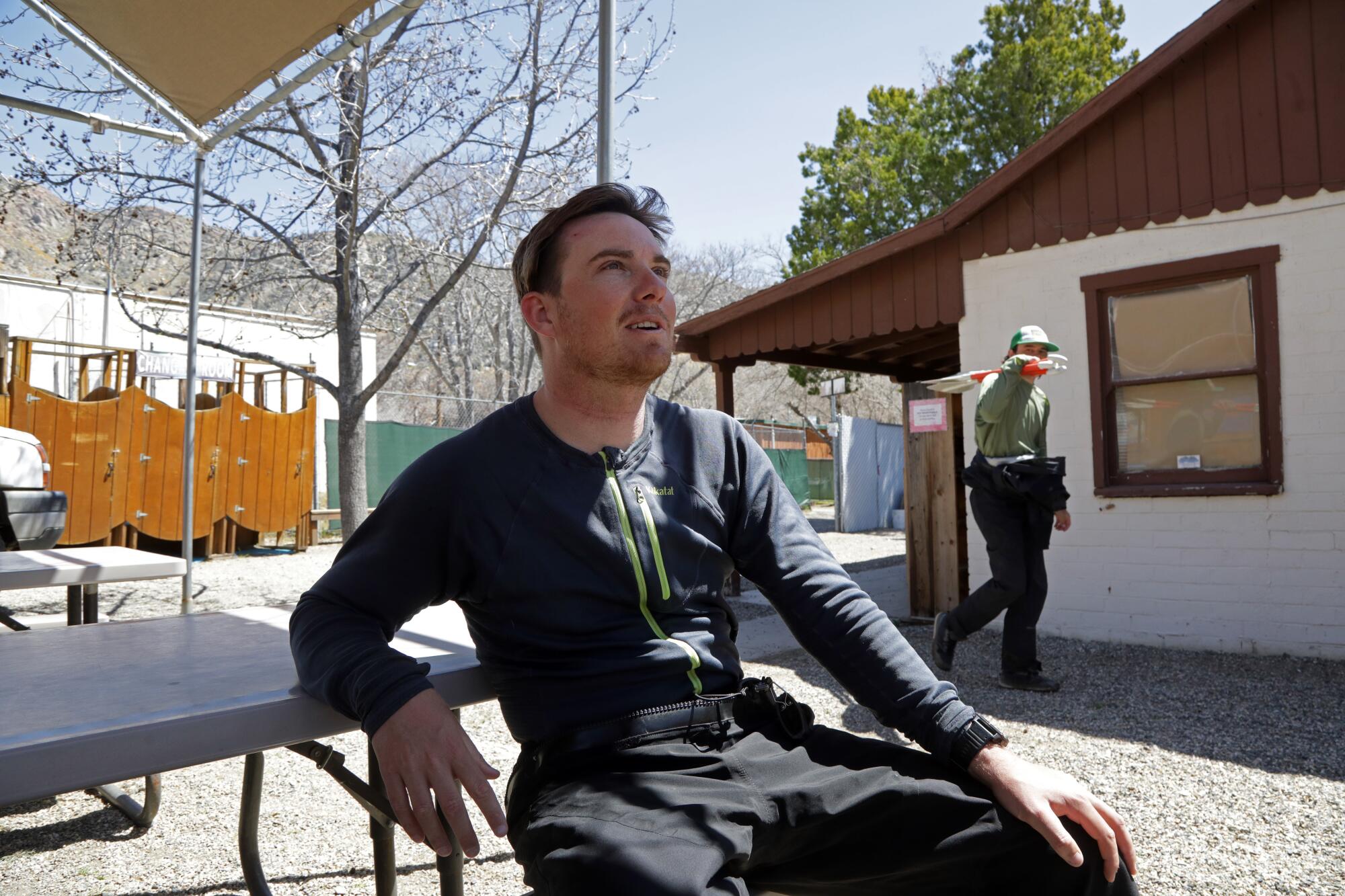
Rafting is generally safe; it can be leisurely if you stick to lower rated rapids. But even with professional guides, the risk is real when the water starts flowing fast.
Since 1972, there have been at least 216 fatal rafting accidents involving commercial companies in the U.S., according to a database maintained by American Whitewater, a nonprofit devoted to protecting access to rivers. Of those, 21 were in California and four were on the Kern.
The most recent, in 2017, involved a 44-year-old client of Sierra South who fell from a raft into 40-degree water on a section of the Upper Kern known as “the Cables,” a celebrated Class IV run. Guides were able to get him back in the raft, but he collapsed. The coroner listed his cause of death as a heart attack.
That was in the back of my mind as I scraped the frost from my windshield just outside Kernville last week, on my way to Sierra South to meet Evan Moore. He was taking four boats filled with other guides on an early season training run through the Cables. I would be the only client.
Unlike the Lower Kern, which is raftable even in drought years thanks to releases from the dam at Lake Isabella, the Upper Kern is free flowing and wild. Because its flow relies on a heavy snowpack, Moore’s company hasn’t been able to run trips on the Upper Kern since 2019.
This was going to be an adventure for everyone.
Both the water and air temperatures were in the 40s as I squeezed my middle-aged body into multiple layers of neoprene, trying my best to guard against the cold shock to come. Gathered beside the river for our safety talk, we could already hear the rumble of the first rapid only a few dozen yards downstream.
The talk was friendly but detailed. If you fall in, Moore said at the start, “smile.” It happens and it’s part of the fun. While you’re in the water keep your feet up, making sure they’re always near the surface. The greatest danger is getting a foot caught in a crack between rocks or on a submerged log. When that happens, the force of the water can easily break your leg or, worse, bend you over and pin you down, possibly with your face submerged.
Also, if you end up going through the rapids outside of the boat, Moore said, “keep your eyes open.” You’ll have to time your breaths, he explained, so make sure to inhale only when you can see the light.
That was the moment I silently resolved to stay in the boat, no matter what.
I spent the next three hours wiggling my feet deep into the rubber folds on the floor of the raft as we paddled and pounded down the ice-cold river. It worked; I never fell out.
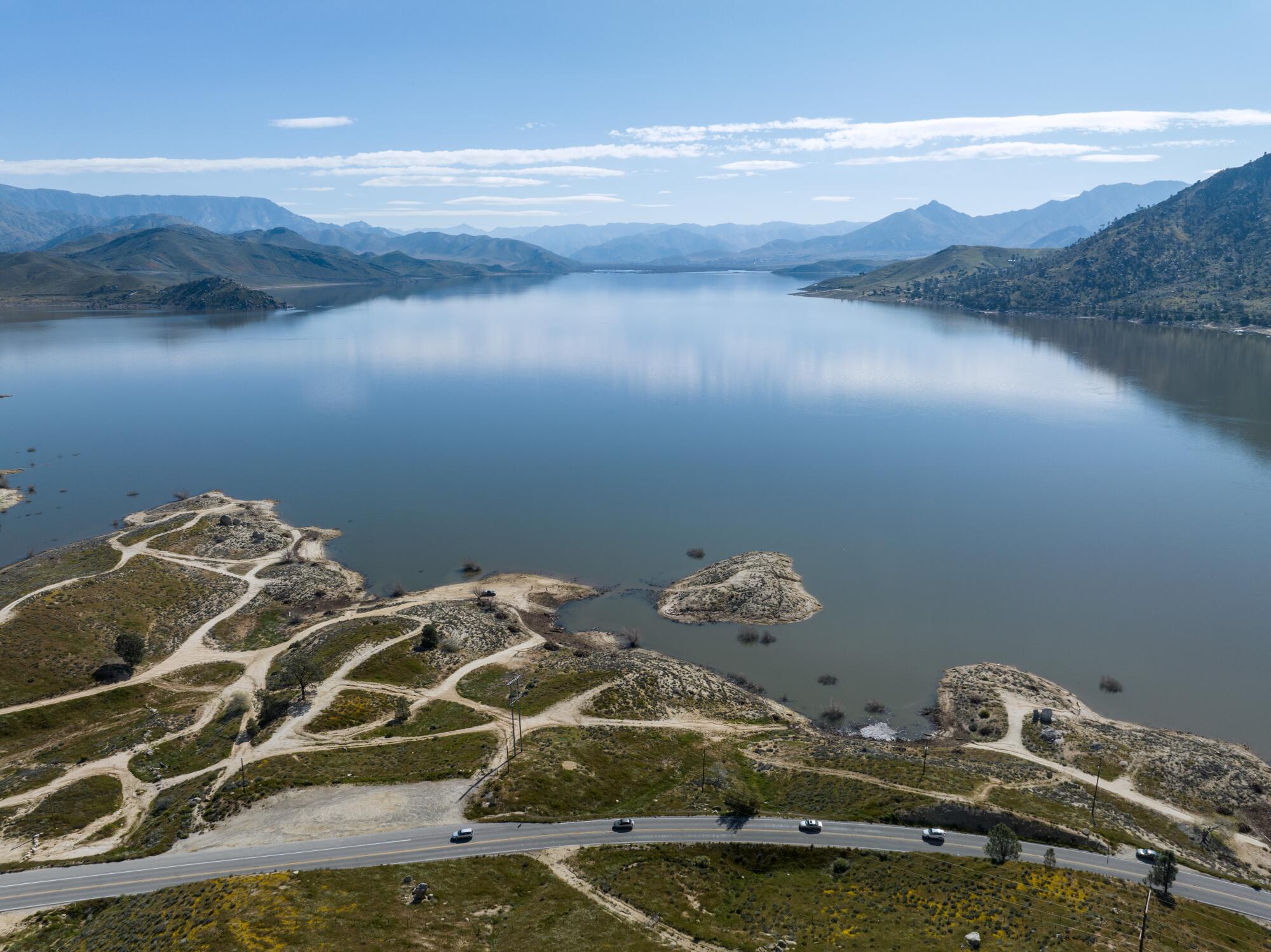
A guide in one of the other boats did go overboard, but he wasn’t in the water for more than five seconds. Without even looking, he casually reached behind his head for a line rigged on the outside of the raft and the other guides hauled him in with no drama.
But the river had changed a lot.
In March, during one of many storms, it overwhelmed its banks and nearly washed Kernville off the map. The water usually flows through town at about 2,000 cubic feet per second in spring. During the flood, it reached 45,000 cubic feet per second, topping a 50-year record and prompting mandatory evacuations.
As we paddled downstream, experienced eyes spotted new features everywhere. Immense tangles of uprooted trees lined the banks.
But just beyond the banks, the hillsides, which had been dingy brown during the drought, were green and lush. The super-bloom was just beginning to suffuse wide swaths of the slopes in purple and orange.
Behind us, the towering peaks of the southern Sierra were covered in white, the deepest snowpack ever recorded there and nearly three times what’s normal for this time of year.
It was easy to believe the spring-like rafting conditions could last until fall.
“It’s going be one of the best rafting years we’ve ever seen,” Moore said.
More to Read
Sign up for Essential California
The most important California stories and recommendations in your inbox every morning.
You may occasionally receive promotional content from the Los Angeles Times.
